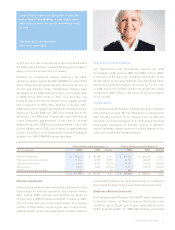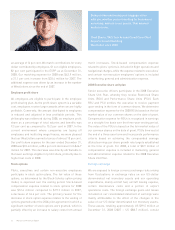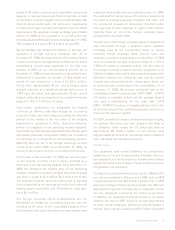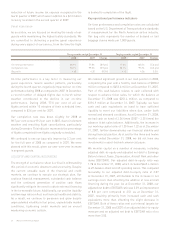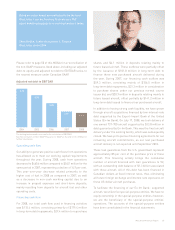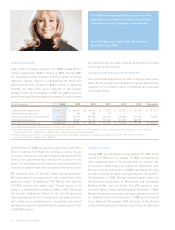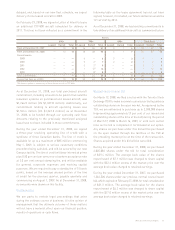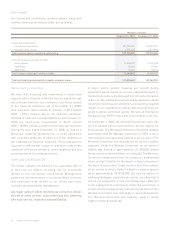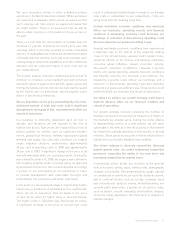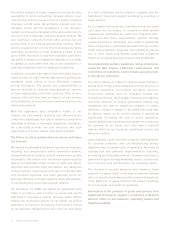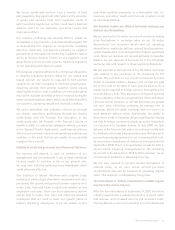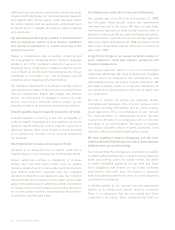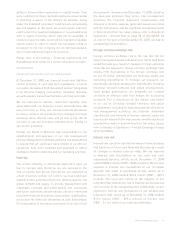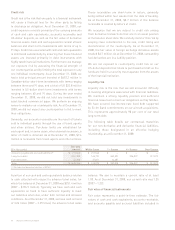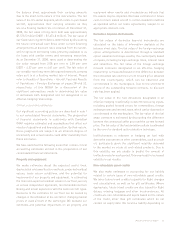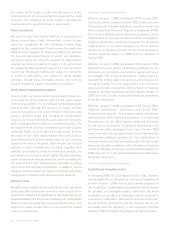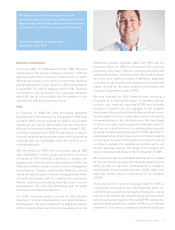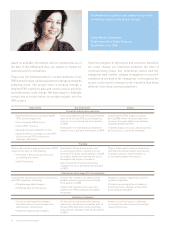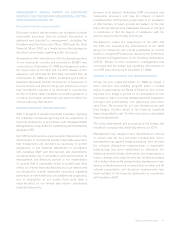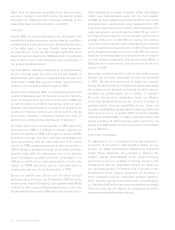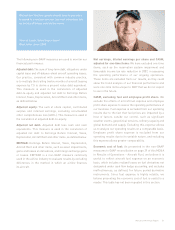Westjet 2008 Annual Report Download - page 45
Download and view the complete annual report
Please find page 45 of the 2008 Westjet annual report below. You can navigate through the pages in the report by either clicking on the pages listed below, or by using the keyword search tool below to find specific information within the annual report.WestJet 2008 Annual Report 41
We secure goods and services from a number of third
party suppliers. Any signifi cant interruption in the provision
of goods and services from such suppliers, some of
which would be beyond our control, could have a material
adverse effect on our business, operating results and
fi nancial condition.
Our reliance on Boeing and General Electric makes us
susceptible to any problems connected with Boeing aircraft
or General Electric engines or components, including
defective materials, mechanical problems or negative
perceptions in the travelling community. In addition, labour
action at Boeing, General Electric or key suppliers could
delay delivery of new aircraft or parts, impacting negatively
on our operating and expansion plans.
If Boeing was unable to adhere to its contractual obligations
in meeting scheduled delivery dates for our owned and
leased aircraft, we would be required to fi nd another
supplier for aircraft or engines to fulfi ll our growth plans.
Acquiring aircraft from another supplier would require
signifi cant transition costs. In addition, aircraft and engines
may not be available at similar prices or received during the
same scheduled delivery dates, which could adversely affect
our business, operating results and fi nancial condition.
We derive operations and utilization effi ciencies through
our charter operations, particularly through our charter
relationship with Air Transat. Any disruption in the
relationship with Air Transat or Air Transat’s failure or
inability to fulfi ll its contractual obligations with us, pursuant
to the Transat Charter Agreement, could have an adverse
effect on our business, results from operations and fi nancial
condition in the event that we are unable to successfully
redeploy these aircraft.
Inability to retain key personnel could harm our business.
Our success will depend, in part, on members of our
management and key personnel. If any of these individuals
become unable to continue in his or her present role,
we may have diffi culty replacing these individuals, which
could adversely affect us.
Our business is labour intensive and requires large
numbers of pilots, fl ight attendants, mechanics and other
personnel. Our growth and general turnover requires us to
locate, hire, train and retain a signifi cant number of new
employees each year. There can be no assurance that we
will be able to locate, hire, train and retain the qualifi ed
employees that we need to meet our growth plans or
replace departing employees. If we are unable to hire
and retain qualifi ed employees at a reasonable cost, our
business, operating results and fi nancial condition could
be adversely affected.
Our fi nancial results are affected by foreign currency and
interest rate fl uctuations.
We are exposed to US-dollar currency fl uctuations arising
from fl uctuations in exchange rates on our US-dollar
denominated net monetary assets and our operating
expenditures, mainly aircraft fuel, aircraft leasing expense,
certain maintenance costs and a portion of airport operations
costs. Since our revenues are received primarily in Canadian
dollars, we are exposed to fl uctuations in the US-dollar
exchange rate with respect to these payment obligations.
We are exposed to fl uctuations in the US-dollar exchange
rate relating to the purchases of the remaining 24 737
aircraft. The purchase of our aircraft is fi nanced by funds
drawn in Canadian dollars; however, the aircraft are paid
for in US funds at the date of each aircraft delivery. As a
result, we are exposed to foreign currency fl uctuations prior
to each delivery date. This exposure is mitigated by fi xing
rates in advance of delivery at appropriate times and where
rates are not yet locked in, or aircraft deliveries are spread
out over time, effectively achieving an average rate of
exchange, as the US-dollar exchange rate is locked in at
each separate delivery point. Additionally, the ability to
draw these funds in Canadian dollars signifi cantly reduces
our risk to foreign currency fl uctuations, as the majority of
our revenue is in Canadian dollars. In July 2008, we took
delivery of the fi nal aircraft under our previous facility with
Ex-Im Bank, which was subsequently closed. We have yet to
pursue fi nancing agreements for our remaining 24 aircraft,
as our next purchased aircraft delivery is not expected until
September 2010. There is no guarantee we will be able to
secure similar fi nancing arrangements for the remaining
24 aircraft to be delivered in 2010 to 2013; however, we do
not anticipate problems in obtaining fi nancing.
We are also exposed to general market fl uctuations of
i
nterest rates, as we have future aircraft purchase
commitments that will be fi nanced at prevailing market
rates. This exposure is mitigated by fi xing rates.
Terrorist attacks or military involvement in unstable regions
may harm the airline industry.
After the terrorist attacks of September 11, 2001, the airline
industry experienced a substantial decline in guest traffi c
and revenue, and increased security and insurance costs.
The heightened concern over potential terrorist attacks and


